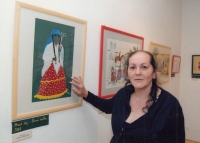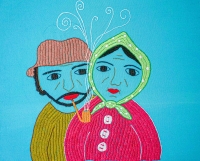I infuse freedom into my embroidery

Download image
Markéta Šestáková, née Kaiserová, was born on 17 January 1952 in České Budějovice to a Romani mother and Czech father. Markéta Šestáková knows nothing about her mother, who died a few months after giving birth. Her father was not interested in her. At a very early age she was placed in an infant institution and then, until she was 14, she stayed in various orphanages. Her memories of the orphanages are among the happiest of her life. There she found safety, closeness and a community to which she belonged. Markéta Šestáková was very talented from a young age. At the age of fifteen she wanted to go into teaching, and thought about designing shoes in Zlín. At this time, the Kaisers, her father’s relatives, took her in from the orphanage. However, Markéta Šestáková was only someone who would earn money for the family. They arranged a job for her at the Koh-i-noor company in České Budějovice, which she had to take up at the age of fifteen. She hated working there. At the age of 16, she ran away to Slovakia, where her father’s second wife lived in a Roma settlement in Humenne. She spent one whole year in Humenne. She gives valuable testimony about life in the Roma community in the late 1960s. This stay also became a great inspiration for her later artistic work. After returning to České Budějovice, she met her husband, with whom she later had five children. In the 1990s she encountered racist behaviour towards her family. In 1992, she responded to an appeal in the Roma magazine Amaro lav and made her first drawings for them. Since that year she has been freelancing full time, drawing, embroidering, writing short stories and fairy tales, which are published by Kher. Most of her works deal with Romani themes. She cooperates with the Museum of Romani Culture in Brno. In 2023 she lived in České Budějovice.








